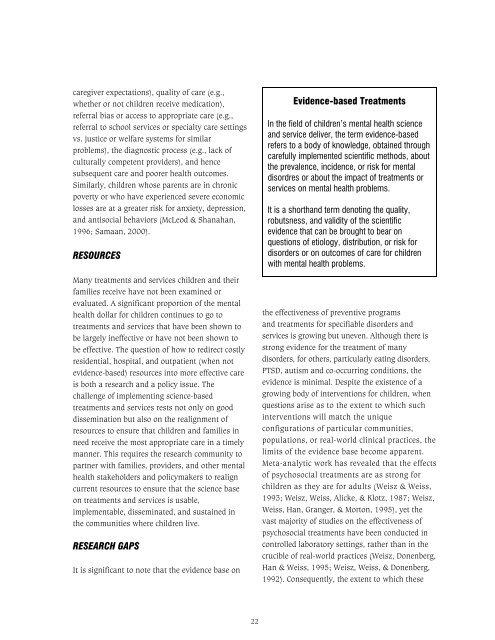Research on Child and Adolescent Mental Health
Research on Child and Adolescent Mental Health
Research on Child and Adolescent Mental Health
Create successful ePaper yourself
Turn your PDF publications into a flip-book with our unique Google optimized e-Paper software.
caregiver expectati<strong>on</strong>s), quality of care (e.g.,<br />
whether or not children receive medicati<strong>on</strong>),<br />
referral bias or access to appropriate care (e.g.,<br />
referral to school services or specialty care settings<br />
vs. justice or welfare systems for similar<br />
problems), the diagnostic process (e.g., lack of<br />
culturally competent providers), <strong>and</strong> hence<br />
subsequent care <strong>and</strong> poorer health outcomes.<br />
Similarly, children whose parents are in chr<strong>on</strong>ic<br />
poverty or who have experienced severe ec<strong>on</strong>omic<br />
losses are at a greater risk for anxiety, depressi<strong>on</strong>,<br />
<strong>and</strong> antisocial behaviors (McLeod & Shanahan,<br />
1996; Samaan, 2000).<br />
RESOURCES<br />
Many treatments <strong>and</strong> services children <strong>and</strong> their<br />
families receive have not been examined or<br />
evaluated. A significant proporti<strong>on</strong> of the mental<br />
health dollar for children c<strong>on</strong>tinues to go to<br />
treatments <strong>and</strong> services that have been shown to<br />
be largely ineffective or have not been shown to<br />
be effective. The questi<strong>on</strong> of how to redirect costly<br />
residential, hospital, <strong>and</strong> outpatient (when not<br />
evidence-based) resources into more effective care<br />
is both a research <strong>and</strong> a policy issue. The<br />
challenge of implementing science-based<br />
treatments <strong>and</strong> services rests not <strong>on</strong>ly <strong>on</strong> good<br />
disseminati<strong>on</strong> but also <strong>on</strong> the realignment of<br />
resources to ensure that children <strong>and</strong> families in<br />
need receive the most appropriate care in a timely<br />
manner. This requires the research community to<br />
partner with families, providers, <strong>and</strong> other mental<br />
health stakeholders <strong>and</strong> policymakers to realign<br />
current resources to ensure that the science base<br />
<strong>on</strong> treatments <strong>and</strong> services is usable,<br />
implementable, disseminated, <strong>and</strong> sustained in<br />
the communities where children live.<br />
RESEARCH GAPS<br />
It is significant to note that the evidence base <strong>on</strong><br />
Evidence-based Treatments<br />
In the field of children’s mental health science<br />
<strong>and</strong> service deliver, the term evidence-based<br />
refers to a body of knowledge, obtained through<br />
carefully implemented scientific methods, about<br />
the prevalence, incidence, or risk for mental<br />
disordres or about the impact of treatments or<br />
services <strong>on</strong> mental health problems.<br />
It is a shorth<strong>and</strong> term denoting the quality,<br />
robutsness, <strong>and</strong> validity of the scientific<br />
evidence that can be brought to bear <strong>on</strong><br />
questi<strong>on</strong>s of etiology, distributi<strong>on</strong>, or risk for<br />
disorders or <strong>on</strong> outcomes of care for children<br />
with mental health problems.<br />
the effectiveness of preventive programs<br />
<strong>and</strong> treatments for specifiable disorders <strong>and</strong><br />
services is growing but uneven. Although there is<br />
str<strong>on</strong>g evidence for the treatment of many<br />
disorders, for others, particularly eating disorders,<br />
PTSD, autism <strong>and</strong> co-occurring c<strong>on</strong>diti<strong>on</strong>s, the<br />
evidence is minimal. Despite the existence of a<br />
growing body of interventi<strong>on</strong>s for children, when<br />
questi<strong>on</strong>s arise as to the extent to which such<br />
interventi<strong>on</strong>s will match the unique<br />
c<strong>on</strong>figurati<strong>on</strong>s of particular communities,<br />
populati<strong>on</strong>s, or real-world clinical practices, the<br />
limits of the evidence base become apparent.<br />
Meta-analytic work has revealed that the effects<br />
of psychosocial treatments are as str<strong>on</strong>g for<br />
children as they are for adults (Weisz & Weiss,<br />
1993; Weisz, Weiss, Alicke, & Klotz, 1987; Weisz,<br />
Weiss, Han, Granger, & Mort<strong>on</strong>, 1995), yet the<br />
vast majority of studies <strong>on</strong> the effectiveness of<br />
psychosocial treatments have been c<strong>on</strong>ducted in<br />
c<strong>on</strong>trolled laboratory settings, rather than in the<br />
crucible of real-world practices (Weisz, D<strong>on</strong>enberg,<br />
Han & Weiss, 1995; Weisz, Weiss, & D<strong>on</strong>enberg,<br />
1992). C<strong>on</strong>sequently, the extent to which these<br />
22

















